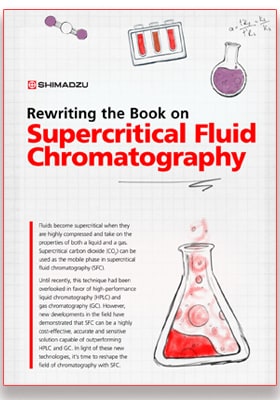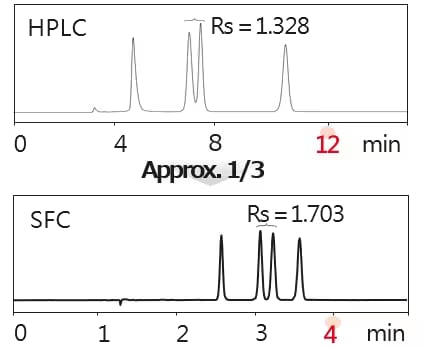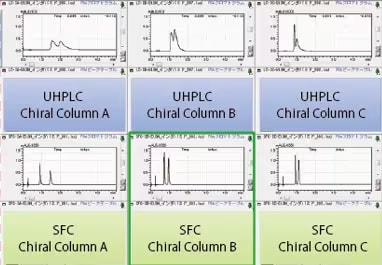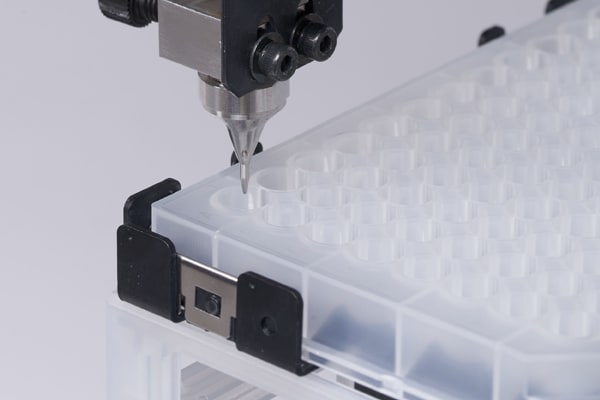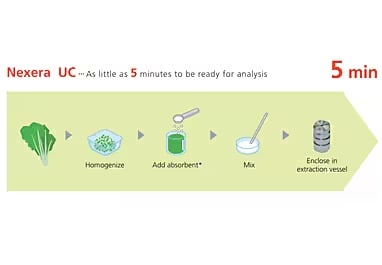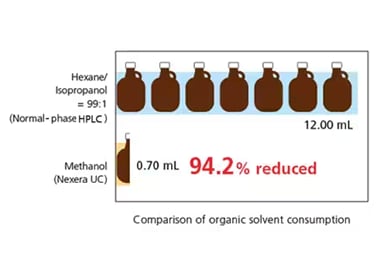Nexera Analytical SFC
Supercritical Fluid Chromatography System
Supercritical Fluid Chromatography System
(with optional supercritical fluid extraction capabilities)
High speed of analysis, sensitivity, and resolution
Supercritical CO2 enables high resolution chromatographic analysis, and the SFE system performs highly efficient sample extraction. The two can be performed on a single system (SFE/SFC system) or separately as needed by the user
High recovery rate of preparative purification with excellent operability
Reliable small volume fractionation is ensured through Shimadzu’s unique collection technology.
Fully automated on-line sample preparation, analysis and fractionation
Target compounds are automatically extracted, analyzed, and fractionated.
Supercritical fluid chromatography (SFC) is a separation method that uses supercritical CO2 as the mobile phase. The benefits of supercritical CO2 are the low polarity similar to n-hexane, the lower viscosity, and the high diffusion coefficient, which offers potential advanced separation methods that are different from conventional HPLC separation. Thanks to this feature, SFC enables unique analyses, such as high resolution chromatography, simultaneous analysis of compounds over a wide polarity range, and improvement of MS detection sensitivity.
For preparative scale, Nexera Prep SFC is Here
Features
-
The analysis time can be effectively shortened because an excellent chromatographic resolution can be maintained even at higher flow rates than those typically used for HPLC.
-
Separation results can be quickly obtained during method development by screening with both SFC and UHPLC.
-
By using a fraction collector, small-volume fractionation is also possible (ex: 96 well MTP's.)
-
Target compounds are extracted from solid samples, and then automatically transferred to SFC.
-
By using SFC, the consumption of organic solvent is reduced by 94.2%, compared to the normal-phase.
Latest Webinar
Videos
-
SFC Is As Easy As HPLC
Today’s SFC systems are setting new standards for performance and ease of use. Yet many chromatographers still haven’t made the switch. Why They’ve likely heard many of the common myths about this remarkable technology! And there are quite a few!
-
Harnessing the Power of Collaboration: Shimadzu’s SFC Journey
Join us as we discuss the collaborative process that led from the introduction of Shimadzu’s Nexera UC analytical SFC systems to the Pharma-focused creation and launch of the Nexera UC Prep semi-preparative SFC systems. We will explore the uses of SFC and see how the Shimadzu lineup has been shaped to meet the needs of Pharma SFC users through their direct input into instrument and software design and development.
-
Nexera UC Supercritical Fluid Extraction/Chromatograph System Narration Eddition
-
Simplifying Medicinal Chemistry Workflows Using Shimadzu Nexera UC Prep
Medicinal chemists need to quickly purify a wide range of drug candidates and intermediates. The Shimadzu Nexera UC Prep semi-preparative supercritical fluid chromatography system delivers outstanding performance in a compact footprint to provide you with the fastest, most accurate and most reliable results.



